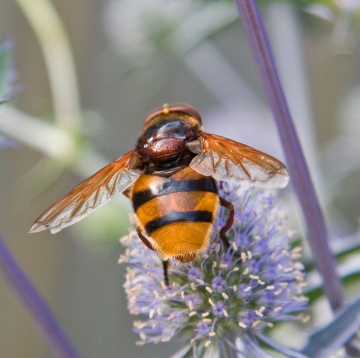Species Account for Volucella zonaria
Volucella zonaria (Poda, 1761)
Diptera: Syrphidae: Syrphidae

Reproduction for study and non-profit use permitted, all other rights reserved.
Taxonomic group: hoverflies (Diptera: Syrphidae) - Available county data
View time series maps for Volucella zonaria
member log-on for taxon report
Essex RDB: Listed
Threat: Regionally Important
Images
upload a new image
Essex Red Data List comment
Formerly a rare migrant species. This hoverfly established itself in Britain in the London area during the 1950s. Since then it has become fairly frequent in south Essex near to the Thames where it is often found in gardens. Nationally it is still scarce
Species text
This, our largest and most spectacular hoverfly, seems to be almost entirely anthropogenic in Britain. Its larvae are scavengers and predators in the nests of social wasps (including the hornet Vespa crabro), where they probably feed on larvae and pupae. It is usually seen visiting flowers in suburban areas where it occurs in parks and gardens. Many recent records come from civic amenity plantings around car-parks and urban roads (Ball & Morris, 2000). Until about 1940 it was regarded as a rare vagrant to the south coast of England, then, during the 1940s, it began to become established in the London area and is now quite frequent, especially in the outer suburbs and in northern Kent. Current evidence shows this species is expanding its range into Suffolk and Norfolk, and north and west from London into Hertfordshire and along the Thames valley (Stubbs & Falk, 2002). References
Habitats
Recorded management for locations with Volucella zonaria
Recorded substrate and hydrology for locations with Volucella zonaria
Why not join the Club, register and add a new species page
Interpretation of distribution maps
























